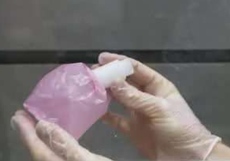New inhalable measles vaccine may lead to vaccines for other diseases
29 Jun 2010
A team of researchers led by the University of Colorado at Boulder believe a dry powder, inhalable vaccine developed for measles prevention and slated for human clinical trials later this year in India will lead to other inhalable, inexpensive vaccines for illnesses ranging from tuberculosis to cervical cancer.
 The inhalable measles vaccine, developed by a team led by CU-Boulder chemistry and biochemistry Professor Robert Sievers, involves mixing "supercritical" carbon dioxide with a weakened form of the measles virus. The process produces microscopic bubbles and droplets that are dried to make the inhalable powder, which is dispensed into the mouths of patients using a small, cylindrical plastic sack with an opening like the neck of a plastic water bottle.
The inhalable measles vaccine, developed by a team led by CU-Boulder chemistry and biochemistry Professor Robert Sievers, involves mixing "supercritical" carbon dioxide with a weakened form of the measles virus. The process produces microscopic bubbles and droplets that are dried to make the inhalable powder, which is dispensed into the mouths of patients using a small, cylindrical plastic sack with an opening like the neck of a plastic water bottle.
According to the World Health Organization, measles is one of the leading causes of death among young children. In 2008 there were an estimated 164,000 measles deaths in children worldwide -- nearly 450 deaths a day -- and India accounts for about two-thirds of global measles deaths in infants and children. "Clinical trials are the next vital step in making this vaccine widely available," he said.
"One of our primary goals of this project is to get rid of needles and syringes, because they frighten some people, they hurt, they can transmit diseases and there are issues with needle disposal," he said. With the new technology, the inhaled powder is sent directly into the lungs, a good target since measles attacks through the respiratory tract, said Sievers. "A person taking a deep breath from the sack is effectively vaccinated."
Phase One of the clinical trials to test the safety and efficacy of the measles inhalant product are slated to start this summer in Pune, India, and will involve about 180 people, said Sievers. Phase Two of the India clinical trials are expected to involve a larger number of patients.
Sievers, also a fellow at CU's Cooperative Institute for Research in Environmental Sciences, said the measles vaccine development idea grew out of atmospheric chemistry research he and his students were conducting. The team was attempting to determine the chemistry of specific air pollutants in particular regions of the world and how people inhale and process tiny airborne droplets of pollutants.




















